
Frame cracks around a Chevy's steering box. Closed-knuckle front-axle assemblies on early-'70s Fords. Model 20 axles on Jeeps.
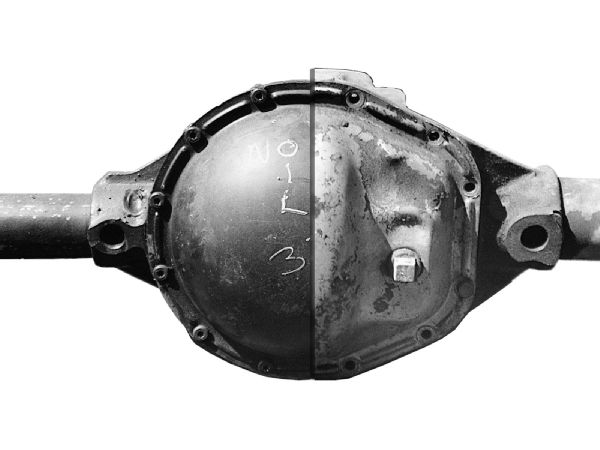
Flaws. Every vehicle has at least one weakness. Others have quite a few. Some problems are easily fixed and don't cost an arm and a leg, but, unfortunately, most flaws aren't easy and can require a sizable investment to be remedied.
The Model 20 was used for 10 years under the back of all CJs and its weaknesses are infamous. Regular on-road-only use with stock-size tires does not usually aggravate the weaknesses, and the diff works just fine, but once you put bigger tires on a Jeep, rocky terrain underneath it, and some extra ponies under the hood, serious breakage is soon to follow.
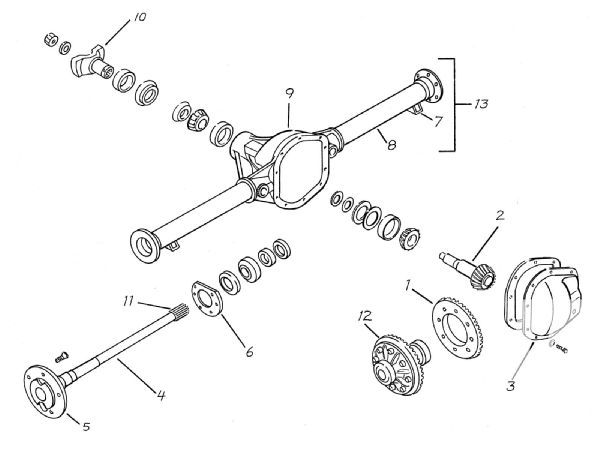 We marked the specific components of an axle assembly to clarify the terms we'll use throughout this article. The parts are as follows: (1) ring gear, (2) pinion gear, (3) inspection cover, (4) axle, (5) hub, (6) axle retainer, (7) spring perch, (8) axle tube, (9) centersection (also called the pumpkin), (10) yoke, (11) axle splines, (12) differential (also called the carrier), and (13) axlehousing.
We marked the specific components of an axle assembly to clarify the terms we'll use throughout this article. The parts are as follows: (1) ring gear, (2) pinion gear, (3) inspection cover, (4) axle, (5) hub, (6) axle retainer, (7) spring perch, (8) axle tube, (9) centersection (also called the pumpkin), (10) yoke, (11) axle splines, (12) differential (also called the carrier), and (13) axlehousing.
A common fix and upgrade is to swap in another axlehousing-most often a Dana 44-and throw away the Model 20. But finding a Dana 44 in good shape is getting more and more difficult, and the cost of a completely rebuilt Dana can be enough to turn people away. As a result, some enthusiasts go with the enormous amount of aftermarket parts available for strengthening the Model 20.
In this article, we'll examine exactly what it takes to upgrade a typical Model 20 versus swapping in a Dana 44. We're keeping a budget in mind and will do a cost comparison to show you how the numbers add up.
To learn the pros and cons of both axles, we went to Tri-County Gear in Pomona, California. The company has been rebuilding axle assemblies for more than 10 years and can customize one to fit almost any application. The staff was able to give us some straight answers, and they had several axlehousings in various stages of assembly so we could compare internal parts.
Swap
The key to properly swapping in a Dana 44 is finding one that will work under a CJ. If you plan to hunt down a 44 on your own, be prepared for some headaches. Many trucks came equipped with the Dana 44, and there are millions of them out there, but there's a catch: There are countless versions. Some are narrow, some are wide, some have tapered (two-piece) axles, and most have different widths and spring-perch locations.
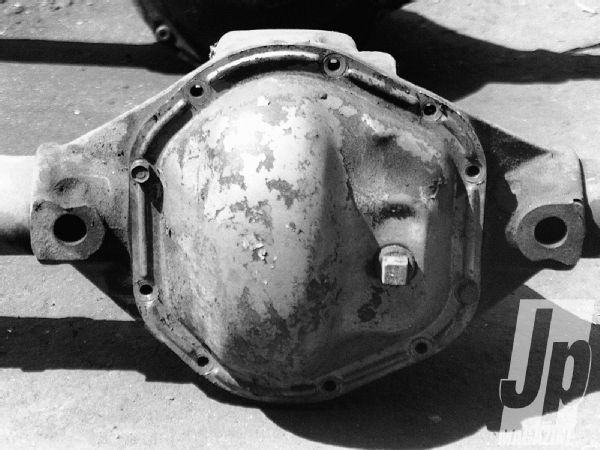 vIdentifying a Dana 44 is a little more difficult. The best identifying marks are the ring-gear bulge to the left of the center of the cover and the fill plug (some didn't have this) to the right of the bulge. Many of the Danas also had their model number cast in one of the webs of the centersection. For example, if you have a Dana 44, the number "44" may be cast somewhere on one of the webs. Not all of them, however, had this mark.
vIdentifying a Dana 44 is a little more difficult. The best identifying marks are the ring-gear bulge to the left of the center of the cover and the fill plug (some didn't have this) to the right of the bulge. Many of the Danas also had their model number cast in one of the webs of the centersection. For example, if you have a Dana 44, the number "44" may be cast somewhere on one of the webs. Not all of them, however, had this mark.
The ideal Dana 44 for this swap is one from a '72-'75 CJ because it's the correct width and has 30-spline, one-piece axles. The spring perches, however, will have to be relocated to fit under a '76-'86 CJ, a task that requires a skilled drivetrain shop like Tri-County. Also, some '76-'79 CJ-7s came with a Quadra-Trac T-case and offset centersections. These will accept a Dana 44 from a '70 1/2-'71 CJ-5 or CJ-6 with the Model 18 transfer case.
Other Danas can be used, but they usually have to be narrowed or otherwise altered, which adds considerable expense. Postal Jeeps came with Dana 44s and can be picked up cheap, but there are other difficulties with swapping one of these Danas under a CJ. The main problem is that the centersection is offset by a few inches. We've been told that a CJ at stock height will accommodate a Postal Dana, but once the Jeep is lifted, the driveline angle gets severe and the U-joints start failing. Postal Danas are also narrower, but this can be corrected with wheel backspacing. We'd stick with a Dana 44 out of a CJ.
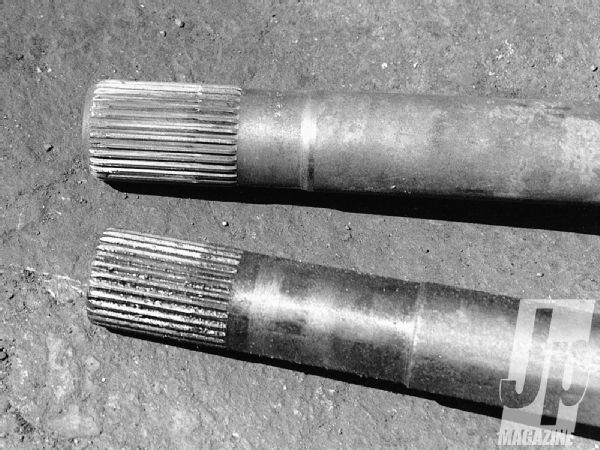 On the carrier side, the axles for a Model 20 (bottom) all have 29 splines, and the axles for the 44 came with four different splines-10, 19, 27, and 30-depending on the year they were produced and the type of vehicle they came under. The '72-'75 CJ Danas had 30 splines, which is considered the strongest.
On the carrier side, the axles for a Model 20 (bottom) all have 29 splines, and the axles for the 44 came with four different splines-10, 19, 27, and 30-depending on the year they were produced and the type of vehicle they came under. The '72-'75 CJ Danas had 30 splines, which is considered the strongest.
The Bottom Line
As always, cost is the bottom line for upgrades. Keep in mind that the prices listed were accurate at the time this article was written and can change at any time. We didn't include labor costs, because they vary greatly from shop to shop. We went to 4 Wheel Parts Wholesalers for prices on the parts to upgrade a Model 20. The company can ship the parts to you. The approximate price for a complete Dana 44 ready to bolt into a CJ with an open differential came from Tri-County Gear, but specific prices depend on what year Jeep you use and any special modifications you may need. The company can customize any axlehousing to fit your application, and it can ship complete assemblies.
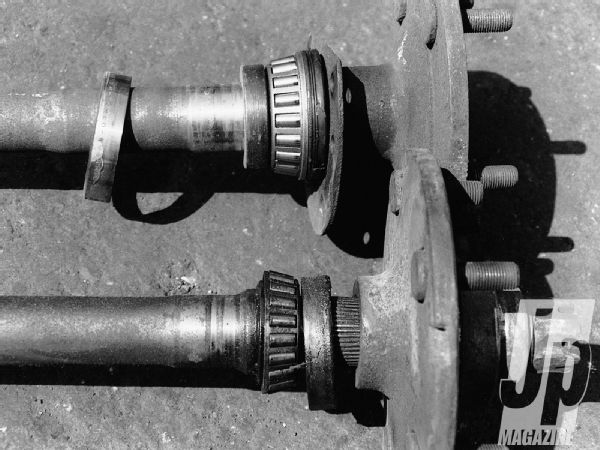 The axleshaft for a 20 (bottom) has a visibly smaller diameter than the shaft for a 44 (top)-another reason the Model 20 is inferior in stock trim. The bearing assemblies are weaker because they're smaller in diameter and width than the bearings in a 44, which means there's less bearing surface and, therefore, more friction and heat.
The axleshaft for a 20 (bottom) has a visibly smaller diameter than the shaft for a 44 (top)-another reason the Model 20 is inferior in stock trim. The bearing assemblies are weaker because they're smaller in diameter and width than the bearings in a 44, which means there's less bearing surface and, therefore, more friction and heat.
The opinion you'll get on which axle is stronger-an upgraded 20 or a stock 44-depends on whom you talk to. We think a beefed Model 20 is every bit as strong as a Dana 44-perhaps even a little stronger because of the larger ring-and-pinion gears. The main difference is the price: Upgrading a Model 20 is about $350 cheaper than swapping in a Dana 44 (we didn't include any extra swap costs, like new brake lines or parking-brake cables, because some applications don't need these). In addition, you get a locker with the upgraded Model 20 we spec out in the chart, which would have to be added to the Dana at extra cost. Dana 44 loyalists may disagree, but we think you'd be surprised at the amount of strength provided by an upgraded Model 20, and you certainly can't dispute the price.
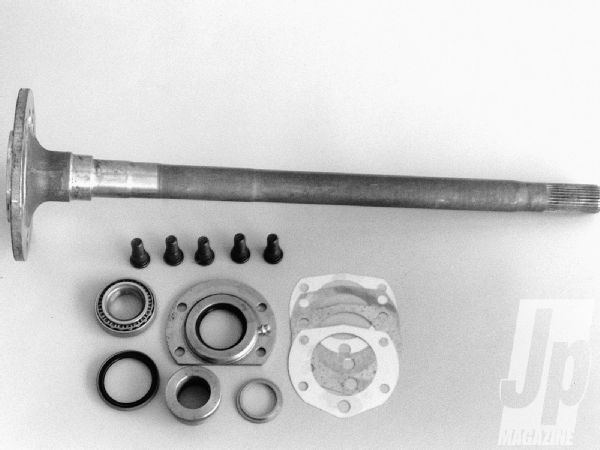 Probably the most common upgrade for a 20 is to swap in aftermarket one-piece axles. The one-piece axles eliminate the outer splines, thereby removing the weakest point of the axles. Available from 4 Wheel Parts Wholesalers and others, the axles are made by Durablue, Genuine Gear, Moser, Summers Brothers, and other companies. The kits usually come with new retainers, seals, bearings, and shims.
Probably the most common upgrade for a 20 is to swap in aftermarket one-piece axles. The one-piece axles eliminate the outer splines, thereby removing the weakest point of the axles. Available from 4 Wheel Parts Wholesalers and others, the axles are made by Durablue, Genuine Gear, Moser, Summers Brothers, and other companies. The kits usually come with new retainers, seals, bearings, and shims.
History And Identification
The Model 20 was used under Jeeps from '76 to '86, then was replaced with the Dana 35C, which is still used today. The 20 was used on all '76-'86 CJ-5s, CJ-7s, and Scramblers regardless of the engine and original equipment. Even if you own a Jeep that was built during the years that the Model 20 was used, don't assume that the 20 is the rearend you actually have. Crawl underneath the truck and take a look; a former owner may have swapped in a different axle assembly.
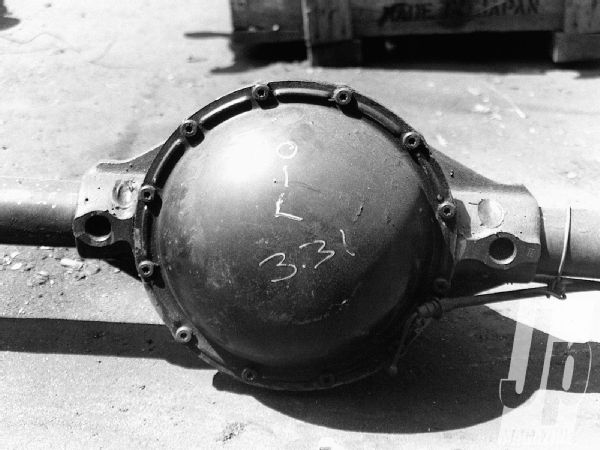 Properly identifying a Model 20 is pretty simple. Take a look at the pumpkin (the centersection of the axlehousing) and examine the diff cover. A Model 20 has a rounded cover with no drain plug, kind of like a ball that has been cut in half. Also, the cover attaches to the axlehousing with 12 bolts.
Properly identifying a Model 20 is pretty simple. Take a look at the pumpkin (the centersection of the axlehousing) and examine the diff cover. A Model 20 has a rounded cover with no drain plug, kind of like a ball that has been cut in half. Also, the cover attaches to the axlehousing with 12 bolts.
The Dana 44 was used on and off throughout the history of Jeeps. The first appearance of the 44 was in 1948, when it was installed under the back of CJ-3As. There was a series of spline and axleshaft changes, and as a result, the housings look different on the outside. The 44 was used up to 1976, when AMC switched to the Model 20. Then in the last half of 1986 there was a switch back to the Dana 44. It was soon replaced by the Dana 35 (some, but not all, of these were C-clips) in 1987. Now the Dana 44 has returned as an option on the '97 TJs.
COMPARING COSTS Model 20 Genuine Gear axles $329.95 Detroit Locker $469.95 Welding $50.00 Total $849.90 Dana 44 Approx. $1,200.00What Is A Full-Floater?
A full-floating axle assembly carries the weight of the vehicle on the axlehousing. The axleshafts don't carry weight, thus they are said to be "floating." Full-floaters are beneficial for 'wheeling, because even when they break, they allow the tires to spin. They're also less likely to break because they're not supporting the weight of the vehicle. If the axleshaft does break, an occasional occurrence when doing serious 'wheeling, the axle on a full-floater can be removed and you can drive home. A broken axleshaft on a regular axle assembly will leave you stranded unless you carry a spare axle.
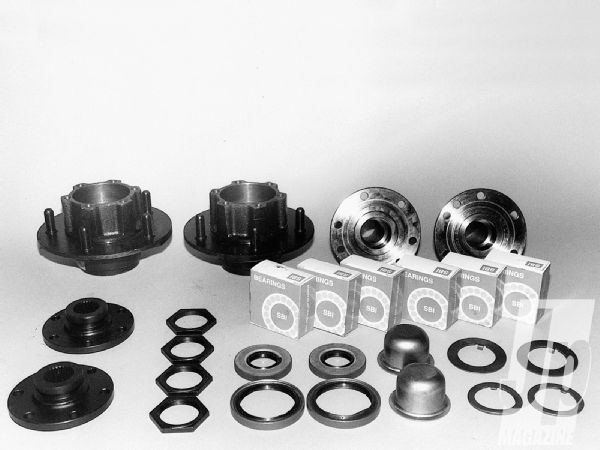 Full-floater conversion kits are available for both the Model 20 and the Dana 44, but they carry a pretty hefty price tag. The full-floater kit shown includes all the pieces necessary to convert a CJ 44. The axleshafts are also included but aren't pictured in the photo. Floater kits are definitely a benefit for serious 'wheeling, but proper installation probably requires an experienced mechanic. Both kits are available from 4 Wheel Parts Wholesalers.
PhotosView Slideshow
Full-floater conversion kits are available for both the Model 20 and the Dana 44, but they carry a pretty hefty price tag. The full-floater kit shown includes all the pieces necessary to convert a CJ 44. The axleshafts are also included but aren't pictured in the photo. Floater kits are definitely a benefit for serious 'wheeling, but proper installation probably requires an experienced mechanic. Both kits are available from 4 Wheel Parts Wholesalers.
PhotosView Slideshow








